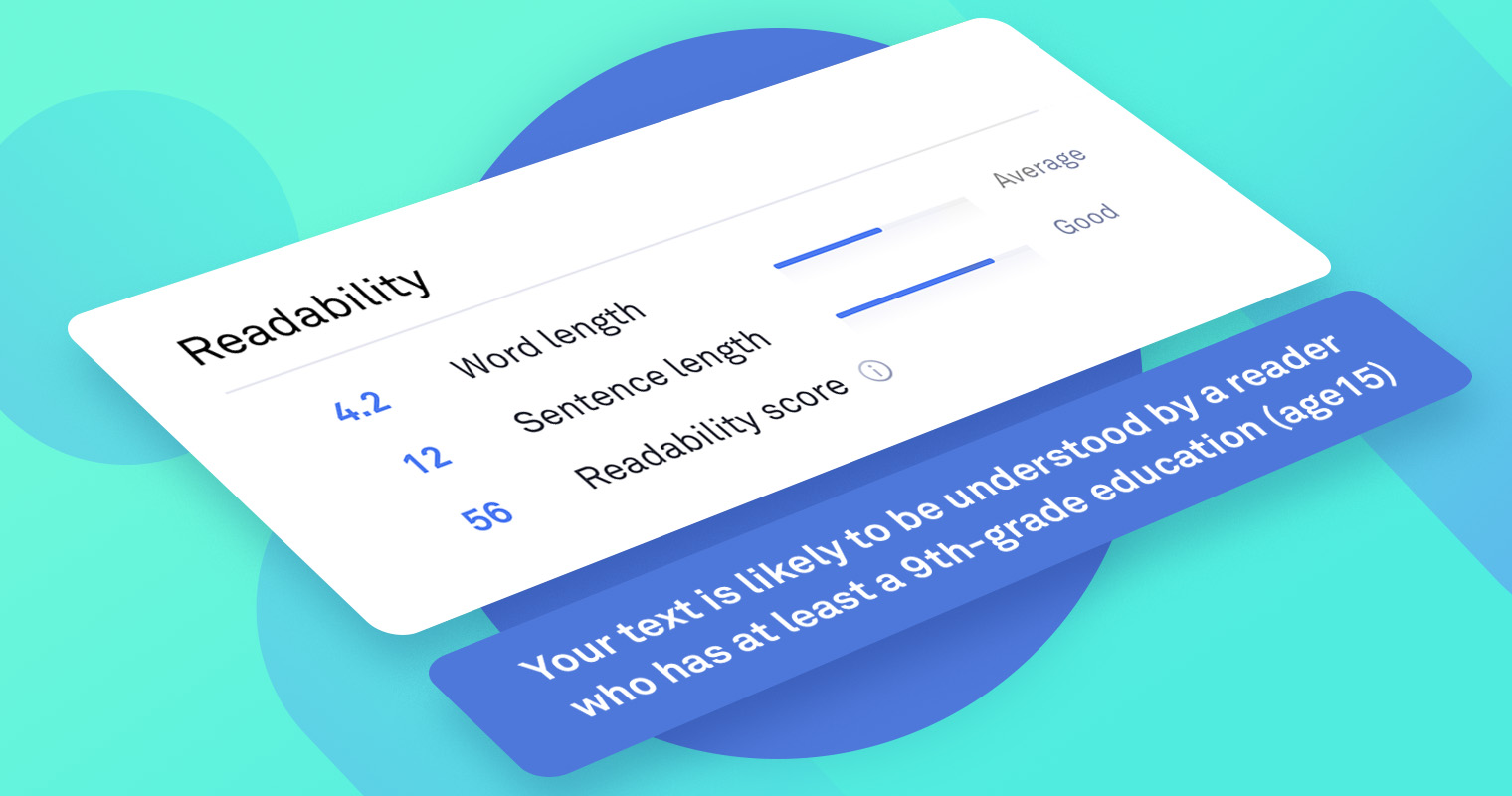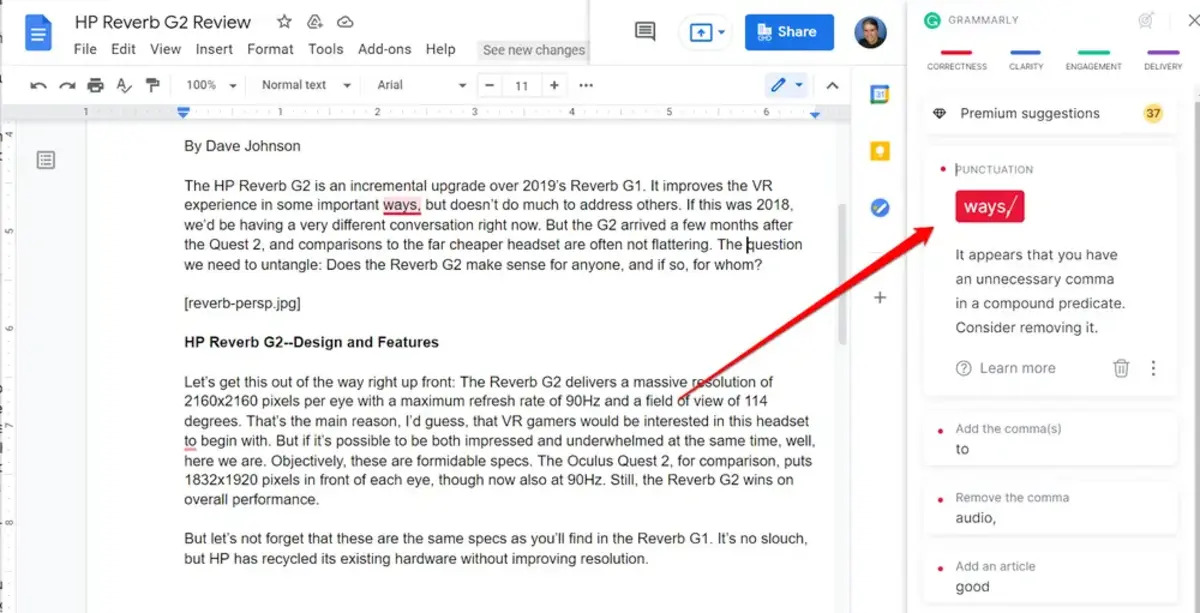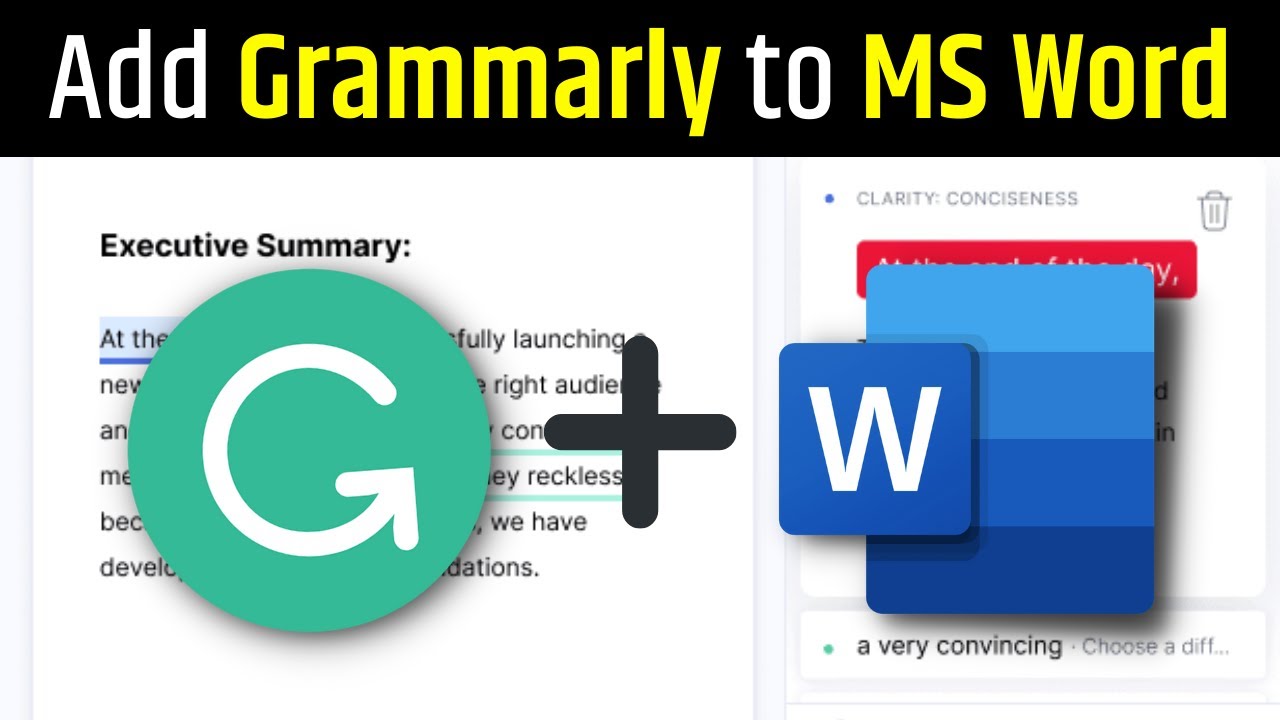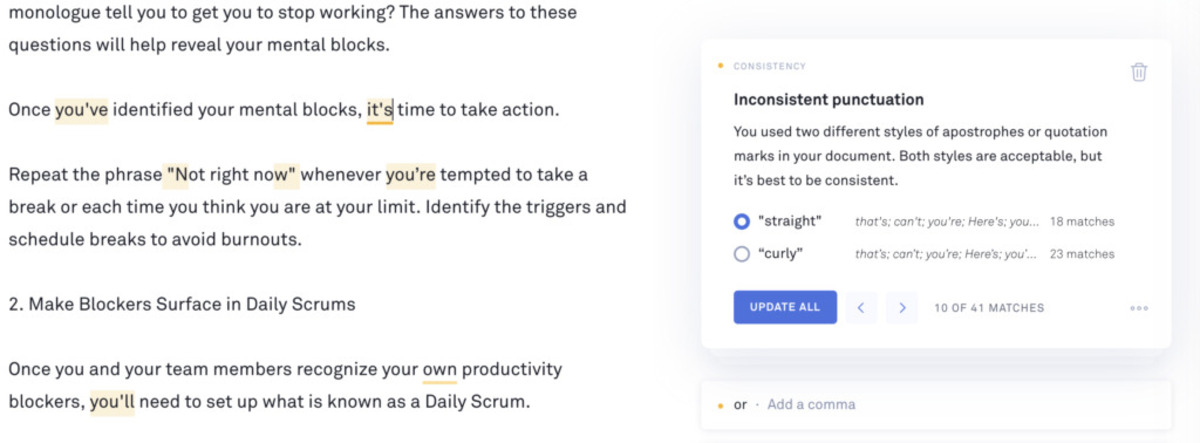What Is the Readability Score on Grammarly
Writing content that is easy to read and understand is crucial for effective communication. Whether you are writing a blog post, an article, or any other type of content, readability plays a significant role in engaging your readers. Grammarly, the popular online writing tool, offers a readability score that helps writers gauge the readability of their text and make necessary adjustments for improvement.
Readability refers to how easy or difficult it is for readers to comprehend a piece of writing. It is influenced by various factors such as sentence structure, word choice, sentence length, and overall organization. When readers encounter content that is difficult to understand, they are more likely to lose interest and navigate away from the page.
Grammarly’s readability score provides writers with an objective measurement of how easy their text is to read. This score is calculated based on a combination of factors to assess the overall readability of the content. By analyzing elements such as sentence complexity, word choice, and paragraph length, Grammarly offers valuable insights that can help writers improve the clarity and effectiveness of their writing.
The readability score on Grammarly ranges from 0 to 100, with a higher score indicating better readability. A score between 60 and 70 is considered good, indicating that the content is easily understood by an average audience. If the score falls below 60, it suggests that the content may need some revision to enhance readability.
Grammarly calculates the readability score using an algorithm that takes into account various linguistic and structural elements. The tool measures sentence length, word length, syllable count, and the complexity of the text to provide an accurate assessment. By analyzing these factors, Grammarly helps writers identify areas where the text may be too dense or difficult to digest.
It is important to note that the readability score on Grammarly is just a tool to guide writers. While it provides valuable feedback, it is not a definitive measure of the quality or effectiveness of the content. Different types of writing may require varying levels of complexity, and the intended audience should also be considered when interpreting the score.
To improve your readability score on Grammarly, consider the following tips:
- Use concise and clear sentences.
- Avoid long and convoluted sentence structures.
- Choose words that are simple and easy to understand.
- Break down complex ideas into smaller, more manageable parts.
- Use headings and subheadings to organize your content.
By implementing these strategies, you can enhance the readability of your writing and ensure that your content is accessible to a wider audience. Remember that readability is not just about making your text easier to read; it is also about making it more engaging and enjoyable for your readers.
Introduction
When it comes to writing online content, it’s not just about conveying information – it’s also about capturing and retaining readers’ attention. The readability of your writing plays a key role in achieving this goal. Readers appreciate content that is easy to understand, engaging, and flows smoothly from one idea to another.
Readable content keeps readers engaged, encourages them to stay on your page longer, and increases the chances of them coming back for more. One of the popular tools that help assess the readability of your writing is Grammarly, an online writing assistant that provides a readability score to help you improve your text.
The readability of a piece of writing refers to how easy or difficult it is for readers to understand the content. Factors such as sentence structure, word choice, paragraph length, and overall organization can greatly impact readability. If your writing is too complex or filled with jargon, it can create a barrier between you and your audience, leading to decreased comprehension and disengagement.
Grammarly’s readability score is a valuable tool that helps you evaluate and enhance the readability of your writing. It provides an objective measurement of how easy your text is to read, and this score can guide you in making necessary revisions and adjustments for improved clarity.
In this article, we will explore the concept of readability in more detail and dive into what the readability score on Grammarly entails. We will discuss how Grammarly calculates this score, the factors it considers, and how you can interpret and leverage the score to enhance your writing. Additionally, we will provide practical tips on how to improve your readability score and create more engaging content.
By understanding the importance of readability and how Grammarly’s readability score works, you can sharpen your writing skills and produce content that resonates with your target audience. So, let’s delve into the world of readability and discover how you can elevate your writing to new heights!
What is Readability
Readability is a fundamental aspect of effective communication in writing. It refers to the ease at which a reader can understand and comprehend written content. When a piece of writing has high readability, it means that the information is presented in a clear and accessible manner, making it easy for the reader to follow along and grasp the intended message.
Several factors contribute to the readability of a text, including sentence structure, word choice, sentence length, and overall organization. Each of these elements must work together harmoniously to create a smooth and engaging reading experience. By carefully considering these factors, writers can optimize the readability of their content and ensure that their intended audience can easily digest the information.
On the other hand, low readability can hinder effective communication. It can create confusion, cause readers to lose interest, and even undermine the credibility of the writer. When a text has low readability, readers may struggle to understand the main points, become frustrated, and ultimately abandon the content.
Readability is particularly important in the digital age, where attention spans are shorter, and competition for readership is fierce. Online readers typically scan content rather than reading it thoroughly, and if the text is not easy to follow, they are likely to move on to something else. By creating content with high readability, writers can capture and retain readers’ attention, making their message more impactful.
Writers must consider their target audience when addressing readability. Depending on the intended readership, the level of complexity and technical jargon will vary. When writing for a general audience or for readers with limited subject knowledge, it is essential to use clear and concise language, avoid excessive use of specialized terminology, and break down complex ideas into easily understandable concepts.
Additionally, the readability of a text can be influenced by the overall purpose and tone of the writing. A formal academic paper may require a higher level of complexity and use of specific terminology, while a conversational blog post may benefit from a more accessible and casual writing style.
Ultimately, readability is the bridge that connects writers with their readers. By prioritizing readability and crafting content that is easily understood, writers can deliver their message effectively, engage their audience, and create a positive and memorable reading experience.
Why is Readability Important
Readability is not just a nice-to-have element in writing; it is a crucial aspect that can greatly impact the success of your content. Here are several reasons why readability is important:
1. Facilitates Understanding: High readability ensures that your message is easily understood by your target audience. When your content is clear, concise, and well-organized, readers can comprehend the information without having to exert extra effort. This leads to greater engagement and a more positive reading experience.
2. Engages Readers: Online readers have short attention spans and are often scanning for relevant information. By improving readability, you can capture and maintain readers’ attention, increasing the chances of them staying on your page longer. Engaging content keeps readers connected, encourages them to explore more of your content, and cultivates a loyal following.
3. Improves Accessibility: Readability is essential for making your content accessible to a wider audience. By using plain language and avoiding complex jargon, you can ensure that individuals with varying levels of language proficiency and subject knowledge can understand and benefit from your content. This inclusivity helps you connect with a broader range of readers.
4. Boosts Search Engine Optimization (SEO): Search engines value high-quality, readable content. By optimizing your writing for readability, you enhance your chances of ranking higher in search engine results. Search engines consider factors such as sentence structure, word choice, and overall readability when determining how relevant and valuable your content is to users.
5. Builds Credibility: Readability plays a role in establishing your credibility as a writer or communicator. When your content is clear and easy to understand, readers perceive you as knowledgeable and trustworthy. Conversely, content that is difficult to comprehend may lead readers to question your expertise or authority on the subject matter.
6. Enhances User Experience: Providing a positive user experience is crucial for maintaining a loyal audience and encouraging return visitors. When your content is readable, readers can effortlessly navigate through your text, find the information they are seeking, and have a satisfying experience on your website or platform.
7. Drives Actions: Whether your goal is to inform, entertain, or persuade, readability is essential for encouraging readers to take action. Clear and well-structured content can help readers make informed decisions, follow instructions, or engage in a desired call-to-action.
By prioritizing readability in your writing, you can create content that is engaging, accessible, and impactful. Whether you are writing an article, blog post, or any other form of written communication, focusing on readability will ensure that your message resonates with your audience and achieves your intended objectives.
What is the Readability Score on Grammarly
The readability score on Grammarly is a valuable metric that helps writers assess the readability of their written content. It provides an objective measurement of how easily readers can understand a particular piece of text. Grammarly’s readability score is represented on a scale from 0 to 100, with a higher score indicating better readability.
The score generated by Grammarly takes into account various linguistic and structural elements of the text, including sentence complexity, word choice, and overall paragraph length. By analyzing these factors, Grammarly provides writers with insights into the overall clarity and effectiveness of their writing.
When you input your text into Grammarly, the tool quickly analyzes it and generates a readability score along with suggestions for improvement. This score is displayed prominently in the Grammarly interface, allowing you to easily gauge the readability of your content.
The readability score serves as a guide for writers to understand the readability level of their content and make necessary adjustments. It offers a quick assessment of how well your writing aligns with readability best practices and helps you identify areas where your text may be too complex or difficult to understand.
Grammarly’s readability score is particularly useful for writers who want to ensure that their content is accessible to a wide range of readers. Whether you are writing a blog post, an article, or even professional emails, aiming for a high readability score can enhance the overall user experience and engagement with your writing.
Furthermore, the readability score on Grammarly provides a tangible way to track your writing progress over time. By comparing the scores of your previous and current texts, you can identify any improvements or areas where you may need to focus your efforts in order to consistently produce highly readable content.
It’s important to note that the readability score on Grammarly is just one tool to help you evaluate your writing. While it provides a useful metric, it should not be the sole determinant of the quality or effectiveness of your content. Different types of writing may require varying levels of complexity, and the intended audience should always be considered when interpreting the readability score.
Ultimately, the readability score on Grammarly assists writers in fine-tuning their writing to make it more accessible, engaging, and effective. By utilizing this feature alongside other writing best practices, you can create content that resonates with your intended audience and enhances the overall readability of your writing.
How does Grammarly Calculate the Readability Score
Grammarly utilizes a sophisticated algorithm to calculate the readability score of your written content. The score is generated by analyzing various linguistic and structural aspects of your text to assess its overall readability. By understanding how Grammarly calculates the readability score, you can gain insights into the factors that influence readability and improve your writing accordingly.
The readability score on Grammarly considers several key elements when determining the ease of understanding of your text:
Sentence Length: Grammarly evaluates the length of your sentences to assess their complexity. Lengthy and convoluted sentences can make it harder for readers to grasp the intended message. Grammarly highlights excessively long sentences and recommends breaking them down into shorter, more digestible ones.
Word Complexity: The choice of words also contributes to the overall readability of your text. Grammarly analyzes the complexity of the words used and provides suggestions to replace complex terms with simpler alternatives when appropriate, making it easier for readers to understand the content.
Syllable Count: The number of syllables in a word can impact how easily readers can pronounce and comprehend it. Grammarly considers the syllable count of the words in your text to identify those that might be challenging for readers. It offers suggestions to replace complex or polysyllabic words with simpler alternatives to improve readability.
Overall Document Complexity: Grammarly examines the overall complexity of your text, taking into account factors such as paragraph length and the distribution of sentence lengths throughout the document. This analysis helps identify sections that may be too dense or difficult to understand, allowing you to make appropriate adjustments for improved readability.
Based on these factors, Grammarly generates a readability score that indicates how easy or difficult it is to comprehend your writing. The score ranges from 0 to 100, with a higher score representing better readability. A score between 60 and 70 is generally considered good, indicating that the content is easily understood by an average audience.
By providing these insights and recommendations, Grammarly empowers writers to make informed decisions regarding their writing style and improve the overall readability of their content. However, it is important to note that while the readability score is a helpful tool, it should be used in conjunction with your own judgment and consideration of the intended audience and context.
Understanding how Grammarly calculates the readability score enables you to identify areas where your writing may require improvement. By implementing the suggested changes and considering the readability factors, you can create content that is more accessible, engaging, and enjoyable for your readers.
What Factors Does the Readability Score Consider
Grammarly’s readability score takes into account several key factors that are crucial in assessing the overall readability of your written content. By understanding these factors, you can gain insights into the elements that influence the readability score and make targeted improvements to your writing. Here are the main factors considered by Grammarly’s readability score:
Sentence Structure: The structure of your sentences plays a vital role in readability. Grammarly analyzes the complexity of your sentence structure and identifies any long or convoluted sentences that might impede understanding. It provides suggestions to make your sentences clearer and more concise, improving the overall readability of your text.
Word Choice: The words you choose impact how easily readers can comprehend your writing. Grammarly evaluates the complexity of your word choices and suggests simpler alternatives when appropriate. By using more accessible language, you can enhance the readability of your content and make it easier for readers to grasp your message.
Sentence Length: The length of your sentences affects the flow and comprehension of your writing. Grammarly considers the length of your sentences and recommends breaking up excessively long sentences into shorter ones. This helps prevent reader fatigue and allows for better overall readability.
Paragraph Length: The length of your paragraphs also influences readability. Grammarly assesses the organization of your text and suggests breaking up long paragraphs into shorter ones. By using shorter paragraphs, you create visual breaks that make your content more digestible and easier to navigate for readers.
Vocabulary Complexity: The complexity of the vocabulary you use can either enhance or hinder readability. Grammarly looks for excessively complex or technical terms and offers suggestions for simpler alternatives when appropriate. Using understandable and accessible language ensures that your writing is more inclusive and can be understood by a wider audience.
Transition Words: The use of transition words and phrases helps to create cohesion and flow in your text. Grammarly considers the presence and appropriate use of transition words, which contribute to the readability of your writing. It encourages the use of these words to connect ideas and guide readers through your content smoothly.
Punctuation: Proper punctuation is crucial for clear communication. Grammarly analyzes your punctuation usage and provides suggestions to ensure consistency and correctness. Accurate punctuation helps readers understand the structure of your sentences and improves overall readability.
By taking into account these factors, Grammarly’s readability score offers valuable insights into the clarity and effectiveness of your written content. It helps you identify areas where your writing may need improvement and guides you in making the necessary adjustments for enhanced readability.
While the readability score is a valuable tool, it is important to remember that it should be used as a guide rather than the sole determinant of the quality of your writing. Other factors, such as the intended audience and the purpose of your content, should also be considered when evaluating overall readability.
By understanding the factors considered by the readability score, you can actively work towards creating content that is clear, engaging, and easily understood by your readers.
Interpreting the Readability Score
Interpreting the readability score provided by Grammarly can help you understand the readability level of your written content and make necessary adjustments to enhance comprehension. By effectively deciphering the score, you can ensure that your writing is accessible to your intended audience. Here are key factors to consider when interpreting the readability score:
Score Range: Grammarly’s readability score ranges from 0 to 100, with a higher score indicating better readability. A score between 60 and 70 is generally considered good, suggesting that the content is easily understood by an average audience. Lower scores may indicate that your content requires revision for improved clarity.
Target Audience: The intended audience plays a crucial role in interpreting the readability score. Different audiences may have varying levels of language proficiency and subject knowledge. While a higher score is generally desirable, it is important to consider the context and purpose of your writing to determine the appropriate readability level.
Content Type: Readability expectations may differ depending on the type of content you are producing. For example, technical or academic writing may naturally have a higher level of complexity, while blog posts or general articles may require a more approachable style. Assess your content based on its specific genre and adjust your readability goals accordingly.
Readability Suggestions: Grammarly provides specific suggestions to improve the readability of your content. Take note of the areas flagged by Grammarly and make necessary adjustments such as simplifying sentence structure, choosing clearer words, or breaking up lengthy paragraphs. Use these suggestions as a guide to enhance comprehension and readability.
Readability vs. Style: While readability is crucial, it should not overshadow your unique writing style or the voice of your content. Strive for a balance between readability and maintaining your distinct writing style. Adapt the readability suggestions to align with your writing goals and desired tone, ensuring that your content remains engaging and authentic.
Iterative Process: Readability should be viewed as an iterative process. Use the readability score as a benchmark and work on improving it over time. As you implement feedback, revise your content, and analyze the impact, you can gradually enhance the readability of your writing and develop a consistent style that resonates with your audience.
Interpreting the readability score allows you to optimize your writing for better audience engagement and comprehension. Utilize the suggestions provided by Grammarly, assess the context of your content, and maintain consistency with your writing goals. By paying attention to the readability score and making appropriate adjustments, you can create content that effectively communicates your message and connects with your readers.
How to Improve Your Readability Score
Improving your readability score on Grammarly not only enhances the clarity and comprehension of your writing but also increases the engagement of your audience. By following these practical tips, you can take active steps to improve your readability score:
1. Use Clear and Concise Language: Focus on using simple, straightforward language that is easily understood by your target audience. Avoid unnecessary jargon, technical terms, and overly complex language that can hinder comprehension.
2. Break Down Complex Ideas: Take complex concepts and break them down into more manageable and easier-to-understand parts. Use examples, analogies, and visual aids to simplify complicated information for your readers.
3. Keep Sentences Short and Direct: Shorter sentences are often easier to comprehend. Aim for clarity by using concise language and avoiding excessive subclauses. Focus on one main idea per sentence to maintain readability.
4. Vary Sentence Length: While shorter sentences are beneficial, a mix of sentence lengths can help maintain reader interest and flow. Incorporate a combination of short, medium, and occasionally longer sentences to create a natural rhythm in your writing.
5. Break Up Paragraphs: Lengthy paragraphs can be overwhelming for readers. Break up your content into shorter paragraphs to make it more visually appealing and easier to digest. Each paragraph should focus on one main point to maintain clarity.
6. Use Headings and Subheadings: Organize your content using headings and subheadings to provide structure and guide readers through your text. Clear headings help readers navigate your content and locate the information they need more quickly.
7. Optimize Word Choice: Select words that are familiar to your target audience and avoid unnecessary complexity. Replace long or technical words with simpler alternatives whenever possible. Ensure that your word choices align with the tone and style of your writing.
8. Proofread and Edit: Take the time to review your content and make necessary revisions. Pay attention to grammar, punctuation, and sentence structure to ensure your writing flows smoothly. Grammarly provides suggestions that can help you improve readability, so carefully consider and implement them.
9. Test and Refine: Monitor the impact of your revisions on your readability score and adjust accordingly. Analyze how changes in sentence structure, paragraph length, and word choice influence the overall readability of your content.
10. Consider Your Audience: Always keep your target audience in mind. Consider their background, language proficiency, and familiarity with the subject matter. By tailoring your writing to their needs, you can enhance readability and effectively communicate your message.
Improving your readability score is an ongoing process. By incorporating these tips into your writing routine, you can ensure that your content is accessible, engaging, and easily understood by your audience. Continuously refining your writing style and adapting to your readers’ needs will help you produce high-quality content with a higher readability score.
Conclusion
Readability is a critical aspect of effective writing. It allows you to communicate your message clearly and engage your audience effectively. Grammarly’s readability score provides valuable insights into the clarity and comprehension of your writing, enabling you to make improvements and optimize the readability of your content.
By understanding how Grammarly calculates the readability score and considering factors such as sentence structure, word choice, and paragraph length, you can make targeted adjustments to enhance the overall readability of your writing. The score serves as a guide, helping you tailor your content to your intended audience and communication goals.
Improving your readability score requires actively implementing strategies such as using clear and concise language, breaking down complex ideas, varying sentence lengths, breaking up paragraphs, and optimizing word choice. By incorporating these techniques into your writing process, you can create more accessible and engaging content that resonates with your readers.
Remember to continuously test, refine, and measure the impact of your revisions on the readability score. By remaining attentive to your audience’s needs, you can consistently optimize your writing to ensure it is easily understood and enjoyed by your readers.
Ultimately, readability is not just about making your writing easier to comprehend; it is about crafting a powerful and engaging experience for your audience. By prioritizing readability and leveraging Grammarly’s helpful suggestions, you can enhance the effectiveness and impact of your writing in various contexts.
So, embrace the readability score on Grammarly as a valuable tool in your writing journey. Strive to create content that is clear, concise, and accessible to your specific target audience. With practice and continuous improvement, you can achieve higher readability scores, captivate your readers, and deliver your message with clarity and impact.

























